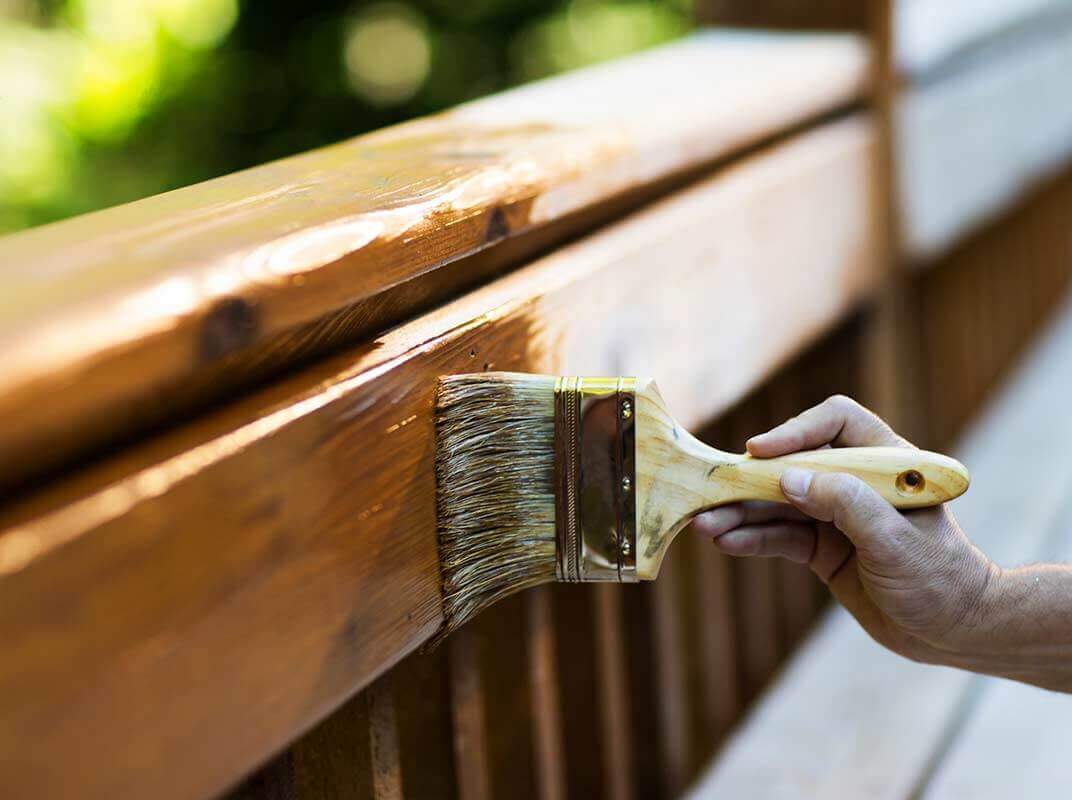
Because wood is an organic material, Mother Earth is always working diligently towards its decomposition. UV rays break down wood fibers. Moisture weakens wood through expansion and contraction. Basically, lumber is in an ongoing battle against nature to maintain its integrity, structure, and strength. While some woods are exceptionally durable – redwood and cedar, for example – all wood is subject to this decomposition process and all requires some human intervention for added protection.
Two of the most common ways to care for your lumber are staining and painting. Each has its own benefits and drawbacks. Here’s what you need to know before you decide.
Why Stain Your Wood
One of the reasons to select wood for a fence or home exterior is because of the look of the material itself. No two planks are alike. Every board has its own wood grain pattern, like a fingerprint unique to a particular tree. Staining lumber allows this natural grain pattern to shine through. As an added bonus, oil-based stains seep into the wood grain itself, providing lasting protection against moisture while the stain’s pigment protects against UV rays.
Gone are the days of plain brown stain. Today’s high-quality stains and sealers feature a wide range of wood tones, clear varnishes, reds, and more. Feel free to experiment with your stain on a test board before beginning your project. Dilute stains or blend colors to create a custom look.
When it’s best to stain:
- If your project is outdoor subject to the elements
- If you have high-quality, nice looking lumber
- If you want to see the wood’s grain
- If you need to protect your wood while retaining a natural look
When Paint is the Perfect Solution
Painting is a fantastic way to protect your wood while creating an attractive, eye-catching point of interest. Though paint obscures the wood grain, rich color draws attention to the forms and shapes of the lumber itself. San Francisco’s Victorian “Painted Ladies” are an excellent example of how contrasting paint can turn a home into a piece of art. Even if you’re not looking for something so drastic, painted exterior siding with contrasting window and door trim can transform your home’s appearance, while a brightly painted fence (even if it’s just white) injects a jolt of instant curb appeal.
If you do plan to paint, Douglas fir is an ideal lumber choice. Though it’s possible to paint all types of wood, because you’re covering up the wood grain anyway, you are free to select a more economical wood.
When it’s best to paint:
- If you want a bright, rich color
- If your lumber is heavily stained or discolored
- If your lumber features no special wood grain
Other Ways to Care for Wood
Painting and staining are certainly the most popular methods for caring for lumber but they’re not the only ways. Here are a few additional options:
- Leave it alone
That’s right. Certain woods (redwood, for example) hold up well on their own over time. While decay is ultimately inevitable, redwood’s inherent stability will cause it to last without additional intervention. As nature takes its course, rich redwood will eventually turn a stunning silver-gray.
- Refresh it
If your lumber is worn out, stained, or just plain dirty, it’s possible to infuse it with new life. Use wood stripper to remove all existing paint or stain, then followed with wood cleaner to extract dirt. Finally, apply wood brightener to re-open the wood’s pores, thus making it more accepting to a fresh coat of stain.
Whether you choose to paint, stain or leave your lumber raw, exterior wood surfaces will always require some level of maintenance. With careful thought about how you want your wood to look and perform, you can determine the long-lasting, great-looking solution that is perfect for you.

Is stained fir wood for outdoor furniture best to avoid carpenter bee damage, or is painted fir wood better for avoiding carpenter bee damage?